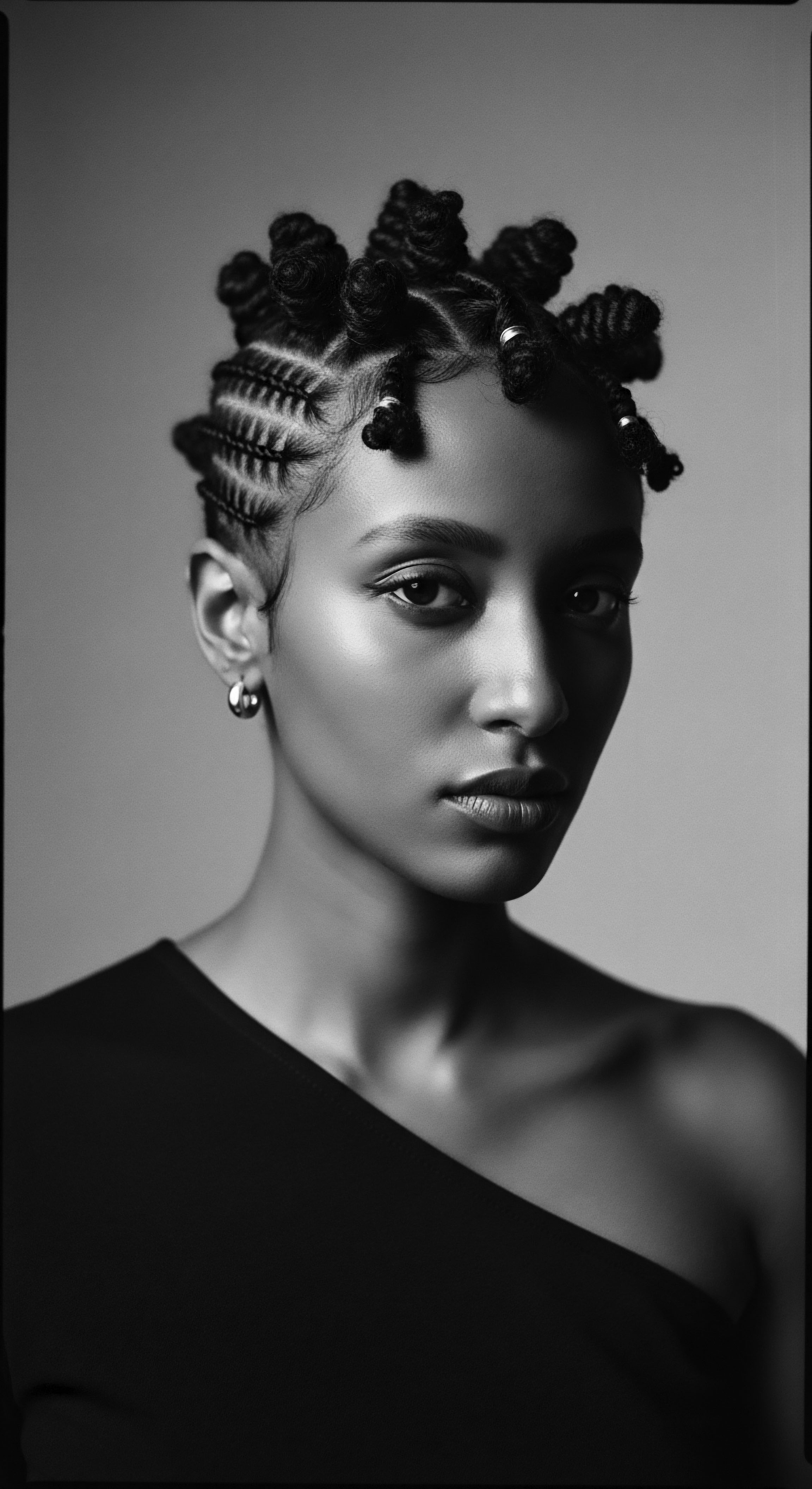
Roots
In the quiet spaces where memory resides, where the whispers of generations past blend with the rustle of leaves, we seek the enduring spirit of textured hair. This strand, this helix of ancestry and resilience, carries within its very structure the wisdom of care, passed down through epochs. Our journey begins not in the sterile halls of a laboratory, nor simply within the fleeting trends of contemporary beauty, but deep in the sun-drenched lands of ancient Kemet, a civilization whose brilliance shaped more than pyramids and hieroglyphs.
It cultivated a profound reverence for personal adornment, viewing hair as a conduit for status, spirituality, and well-being. How did the methods of hair protection, so meticulously practiced along the Nile, echo across millennia to resonate with the vibrant heritage of textured hair today?

What Were Ancient Egyptian Hair Fiber Realities?
The desert clime of ancient Egypt presented stark challenges to hair. Intense sun, arid winds, and fine sand relentlessly sought to dehydrate and abrade strands. The genius of the ancient Egyptians lay in their observational acuity and their deep connection to the natural world. They understood, perhaps intuitively, the protective needs of hair, a wisdom strikingly parallel to the knowledge held within textured hair communities today.
While direct, detailed analyses of ancient Egyptian hair types in relation to modern textured hair classifications are still emerging, archaeological findings often depict styles and practices that speak to the care of hair possessing density, curl, and coiling characteristics. Mummified remains have revealed a range of hair textures, from straight to tightly curled, often remarkably preserved.
Consider the very anatomy of hair. Each strand, a filamentous protein appendage, emerges from the scalp, its integrity determined by a complex interplay of genetics, environment, and care. Textured hair, with its unique elliptical follicle shape, grows in a spiral pattern, leading to varying degrees of curl, wave, and coil. This natural architecture often means a more exposed cuticle layer, which can make it more susceptible to moisture loss and physical abrasion.
The ancient Egyptians, whether tending to their own diverse hair or crafting elaborate wigs, seemed to grasp these vulnerabilities. Their protective approaches were not mere whims of fashion; they were responses to elemental biology, steeped in a practical understanding of hair’s needs within its environment.

How Did Egyptians Conceive of Hair’s Vitality?
For the people of Kemet, hair was far from a mere aesthetic feature. It carried a weighty symbolic load, signifying vitality, status, and even spiritual power. The act of maintaining healthy hair, through cleansing and anointing, was interwoven with broader concepts of purity and connection to the divine.
Priests, in particular, often shaved their heads, a practice tied to ritual purity, reinforcing the idea that hair, while powerful, also required meticulous management for spiritual clarity. This deep connection between hair and an individual’s essence—their life force—is a sentiment that finds profound resonance within many Black and mixed-race ancestral traditions, where hair often symbolizes lineage, identity, and a spiritual conduit to heritage.
Their understanding of hair extended to remedies for various concerns, as evidenced in ancient medical texts. The Ebers Papyrus, a foundational medical text dating back to 1550 BCE, details several concoctions for hair growth and for delaying graying. This manuscript reveals a blend of botanical wisdom and, at times, what we might consider unusual ingredients. Such pursuits underline a universal aspiration to preserve one’s hair and its youthful appearance, a timeless concern that bridges the chasm of millennia.
Ancient Egyptian hair care methods reflect a practical and symbolic understanding of hair’s fragility and its profound connection to identity and vitality.
The detailed depiction of various hairstyles in tomb paintings and reliefs offers a window into the diverse hair practices of the era. These historical canvases showcase a range from closely cropped natural hair to elaborate wigs and extensions, each style carrying specific social meanings. This visual archive suggests that the populace knew different approaches were necessary for distinct hair presentations, a wisdom passed down through centuries.
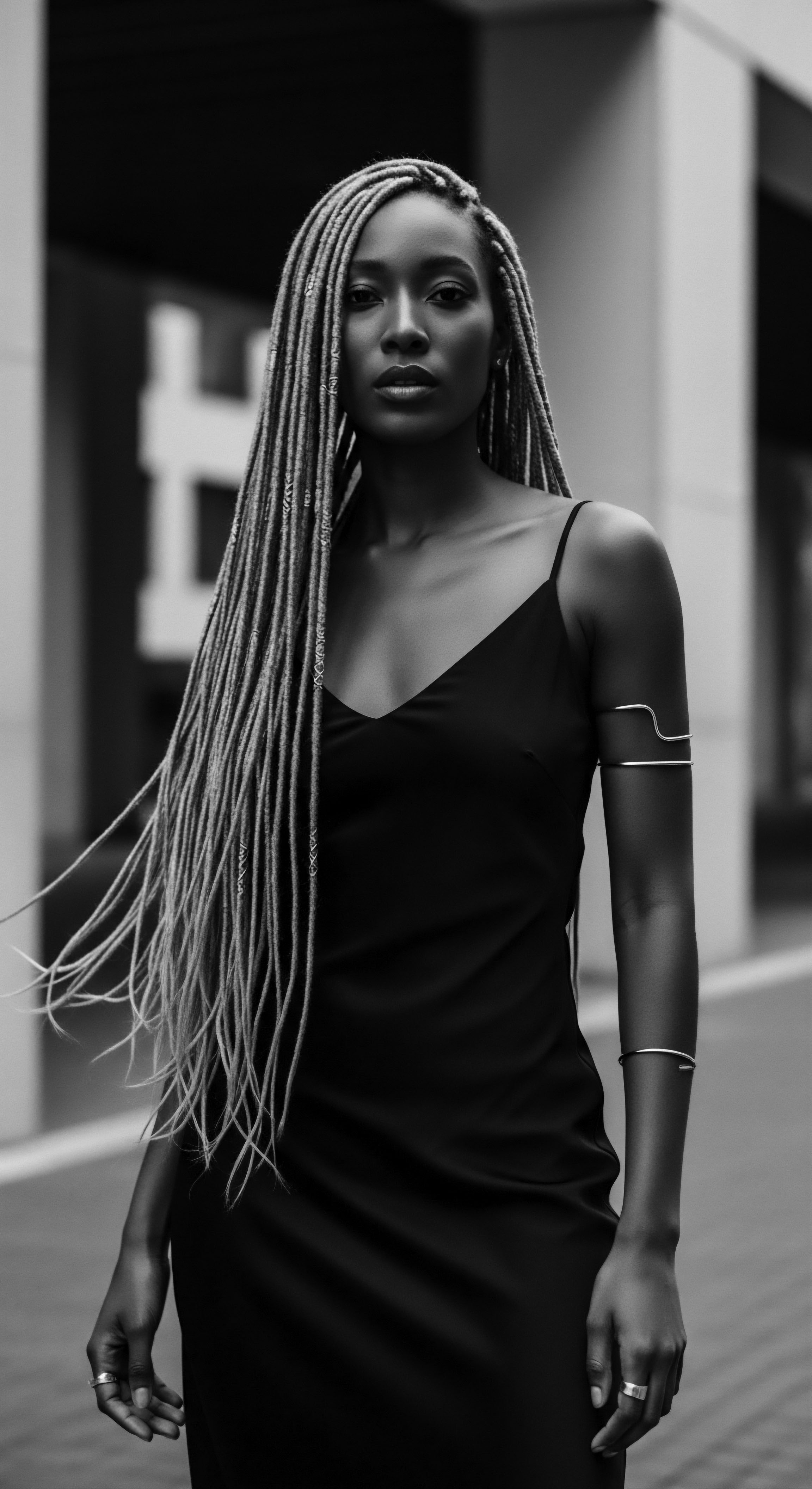
Ritual
The daily rhythm of life in ancient Egypt unfolded with meticulous attention to personal grooming, often elevating care to the level of ritual. For hair, this meant practices designed not only for aesthetic appeal but, more importantly, for protection against the relentless desert environment. These traditional methods, spanning from protective styling to the meticulous application of natural emollients, laid a foundational blueprint for hair preservation, one that speaks directly to the needs and practices within textured hair heritage today.
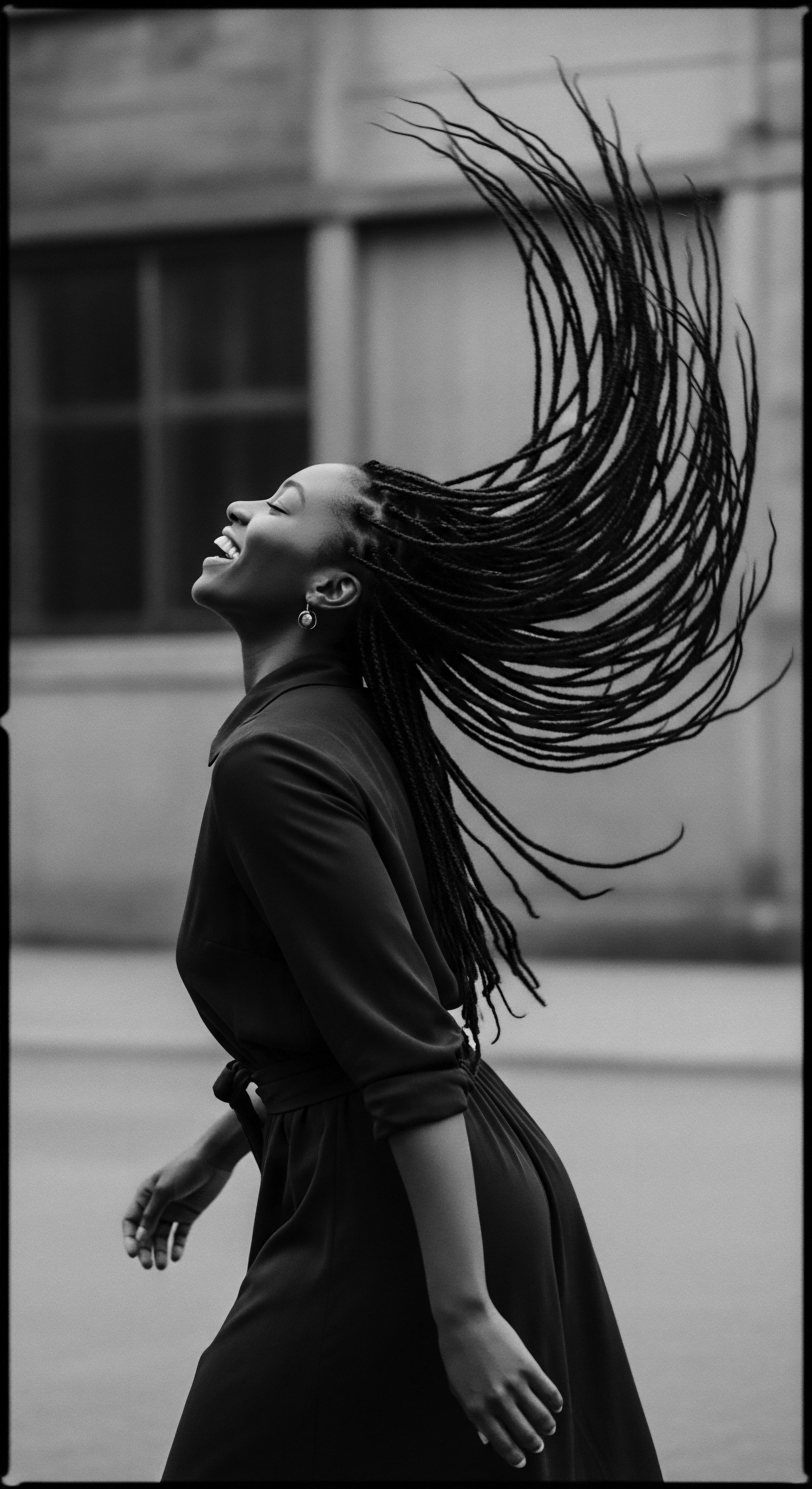
What Protective Styles Did Ancient Egyptians Employ?
One of the most striking parallels between ancient Egyptian hair traditions and modern textured hair care lies in the use of protective styles. Braids, for instance, were a universal language of adornment and protection across African civilizations, including Egypt. Archeological evidence, such as rock paintings in the Sahara dating back to 3500 BCE, shows the earliest depictions of braids, underscoring their ancestral roots in Africa.
In Egypt, braids were worn by men and women across social strata, with varying complexities and adornments denoting status. Whether tightly plaited or styled as components of elaborate wigs, braids served to shield the hair shaft from environmental exposure and mechanical stress.
The practice of braiding hair, an ancestral art form, minimizes manipulation of the hair, preserving length and reducing breakage, principles that are cornerstones of protective styling for textured hair today. Imagine the ancient Egyptian woman, her hair meticulously braided and perhaps adorned with gold thread or beads, a direct echo of how braids, twists, and even locs function within Black and mixed-race communities. These are not merely styles; they are living traditions, forms of hair guardianship passed down through generations. The deliberate organization of hair into compact, lasting forms provides a defense against the elements, a shared wisdom that spans continents and centuries.

How Did Wigs and Head Coverings Serve Protective Aims?
Wigs stand as perhaps the most iconic symbol of ancient Egyptian hair culture, serving both practical and symbolic purposes. These meticulously crafted hairpieces, often fashioned from human hair, sheep’s wool, or plant fibers, provided a formidable shield against the harsh sun, preventing direct exposure of the scalp and natural hair to damaging UV radiation. Furthermore, they served a vital hygienic function, guarding against lice infestations, a common concern in ancient societies. Many Egyptians, particularly those of the elite, shaved their heads for cleanliness and then wore wigs over them, creating a cool, protected environment for the scalp.
The artistry involved in wig-making was considerable. Ancient Egyptian wigmakers braided human hair into dozens of small plaits, creating voluminous and intricate structures. This historical practice of augmenting natural hair with extensions or full wigs resonates deeply with the contemporary use of wigs and weaves within textured hair heritage.
For centuries, Black women and men have utilized these extensions not only for versatility and artistic expression but also as effective protective styles, allowing natural hair to rest, grow, and remain shielded from daily manipulation or environmental stressors. The continuity of this practice speaks to a persistent need for hair protection, a need understood by our ancestors along the Nile and by textured hair communities today.
| Ancient Egyptian Method Wigs and Head Shaving ❉ Protection from sun, hygiene (lice), and display of status. |
| Contemporary Textured Hair Heritage Connection Wigs and Weaves ❉ Thermal and environmental protection, styling versatility, length retention, and a legacy of adornment. |
| Ancient Egyptian Method Braids and Plaits ❉ Minimized manipulation, structural integrity for hair. |
| Contemporary Textured Hair Heritage Connection Box Braids, Cornrows, Twists ❉ Reduced breakage, length preservation, cultural identity, and communal tradition. |
| Ancient Egyptian Method Oiling and Greasing ❉ Moisture retention, scalp health, sun protection with natural fats and oils. |
| Contemporary Textured Hair Heritage Connection Sealing Moisture with Oils and Butters ❉ Hydration, scalp nourishment, environmental barrier, and ancestral wellness. |
| Ancient Egyptian Method These practices across time reflect an enduring human wisdom in preserving hair's health and symbolic meaning. |

What Role Did Oils and Ointments Serve?
The desert’s aridity necessitated rigorous moisturizing. Ancient Egyptians generously applied various oils and fatty substances to their hair and scalps, serving as a shield against moisture loss and sun damage. Castor oil was a staple, appreciated for its conditioning attributes and its perceived ability to encourage hair growth.
Other natural ingredients included almond oil, honey, and even animal fats from sources like hippopotami and lions, which were combined to create potent conditioning treatments. These applications formed a protective barrier, keeping the hair supple and less prone to breakage.
Modern scientific analysis of hair samples from ancient Egyptian mummies provides concrete evidence of these practices. A study by Natalie McCreesh and colleagues, published in the Journal of Archaeological Science, found that the hair of several mummies was coated in a fat-like substance containing long-chain fatty acids, suggesting the use of a styling product or “hair gel” to keep styles in place in both life and death. This scientific confirmation reinforces the intentionality behind their use of rich, occlusive agents, a practice profoundly mirrored in the textured hair community today. The application of oils and butters for “sealing” moisture into coily strands is a vital step in many regimens, preventing the very dryness and fragility that ancient Egyptians sought to counter.

Relay
The continuity of hair care knowledge across generations, particularly within textured hair heritage, serves as a testament to the enduring wisdom of ancestral practices. Ancient Egyptian methods, far from being mere historical curiosities, echo through contemporary routines, offering insights into holistic well-being and the profound significance of hair protection beyond superficial aesthetics.
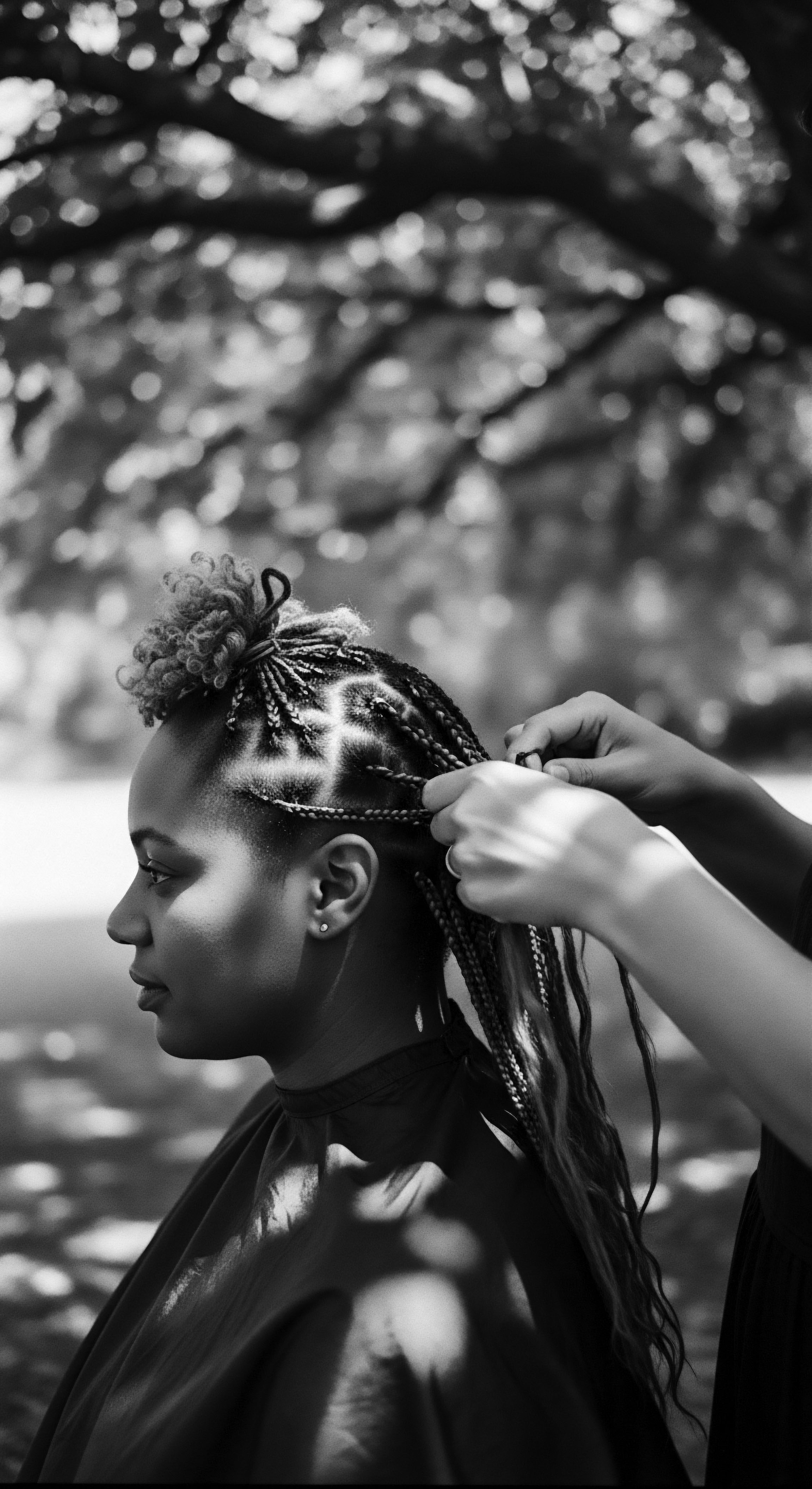
How Does Ancient Egyptian Nighttime Protection Resemble Modern Care?
While specific detailed accounts of ancient Egyptian nighttime hair rituals are not as abundant as other daily practices, the general emphasis on protection and preservation suggests an awareness of continuous care. Given their extensive use of wigs and elaborate styles, it is plausible that methods were employed to maintain these intricate coiffures overnight, preventing tangling and disruption. The use of heavy oils and fats as styling agents and conditioners would also have provided a lasting, protective coating.
This historical inclination toward maintaining hair’s integrity finds a direct parallel in the modern textured hair community’s emphasis on nighttime protection. The use of silk or satin bonnets, scarves, and pillowcases has become a widespread practice, serving to reduce friction, prevent moisture loss, and preserve hairstyles during sleep. This wisdom, passed down through Black and mixed-race lineages, directly addresses the inherent fragility of textured strands, which are prone to tangling and breakage when exposed to rough fabrics. The ancestral knowing that hair needs a sheltered repose is a powerful link, transcending the specifics of material culture to a shared understanding of hair’s vulnerability.
For instance, the protective quality of wrapping hair at night, a common practice in many African and diasporic cultures, functions in much the same way as an ancient Egyptian wig protected the wearer’s natural hair beneath its styled exterior. The underlying principle is simple ❉ minimize external stressors. The environment, whether the dry desert winds of Kemet or the varied climates of the contemporary world, constantly seeks to strip hair of its moisture and compromise its structure. A physical barrier, be it a wig, a headwrap, or a satin bonnet, becomes a crucial defense.
The practice of physically shielding hair, from ancient wigs to modern bonnets, underscores a timeless approach to preserving hair health.
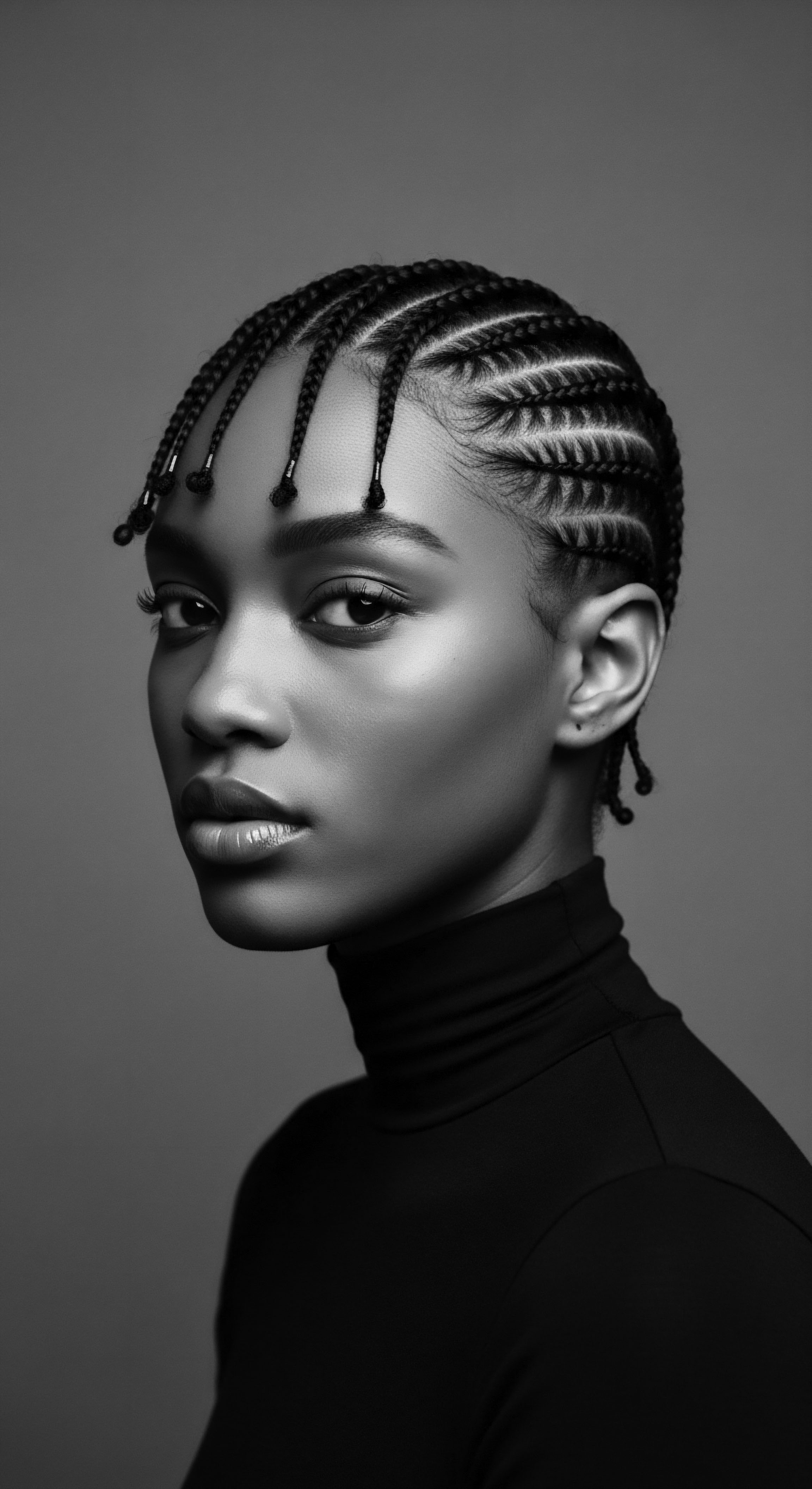
What Ancestral Ingredients Offer Enduring Value?
The ancient Egyptians were master alchemists of nature, turning readily available botanicals and animal products into their sophisticated hair care arsenal. Their reliance on ingredients like castor oil, known for its density and conditioning properties, resonates powerfully. Castor oil, still a highly valued component in many textured hair care lines, offers lubrication and a protective seal for the cuticle, reducing moisture loss.
Consider a few of the core ingredients they favored:
- Castor Oil ❉ Ancient texts and modern product formulations alike laud this oil for its ability to condition and strengthen hair, promoting thickness.
- Henna ❉ Beyond its use as a dye for gray coverage or vibrant reddish tints, henna also functioned as a conditioning and strengthening agent for the hair shaft.
- Aloe Vera ❉ Valued for its soothing and moisturizing attributes, aloe vera found its way into scalp treatments, addressing dryness and irritation.
- Animal Fats and Plant Oils ❉ Diverse fats from various animals, along with plant-based oils, provided the heavy emollients necessary for deep conditioning and styling longevity.
This deep dive into natural ingredients highlights a continuity of understanding concerning hair’s fundamental needs. The properties that made these substances valuable in ancient Egypt—their ability to moisturize, strengthen, and protect—are the same attributes sought after in ingredients formulated for textured hair today. This shared knowledge base, honed over millennia, testifies to a powerful, interconnected ancestral wisdom.

How Do Ancient Hair Rituals Address Holistic Well-Being?
The ancient Egyptian approach to beauty was rarely superficial. It was intertwined with concepts of health, hygiene, social standing, and spiritual connection. Hair care, therefore, was a holistic practice. It was not merely about outward appearance but about maintaining a state of purity and vitality.
This perspective is a powerful undercurrent in textured hair heritage, where hair care routines often extend beyond physical steps to become acts of self-care, community bonding, and a celebration of identity. The communal aspect of hair braiding, for instance, has roots in ancient African societies where creating intricate styles took hours, fostering social connection.
This holistic view also manifests in problem-solving. For issues like hair loss, ancient Egyptians devised various remedies, however bizarre some may seem to modern sensibilities. The Ebers Papyrus, for instance, describes a mixture of animal fats—from lion, hippo, and crocodile—as a treatment for baldness.
While the efficacy of such mixtures is certainly debatable from a scientific standpoint, the very presence of these remedies speaks to a profound concern for hair retention and a persistent belief in the power of natural compounds to restore balance. This historical quest for hair health, even in the face of baldness, underscores the enduring value placed on a full, well-cared-for head of hair—a value deeply embedded within the cultural psyche of textured hair heritage, where hair loss can carry significant emotional weight.
The methods of ancient Egyptians resonate with textured hair heritage through their emphasis on preservation and honor. From protecting delicate strands from the environment to creating intricate styles that communicated social standing, the underlying principle was always one of care and reverence. The legacy of these practices lives on in the daily rituals of many with textured hair, a continuous thread stretching back to the vibrant civilization on the Nile.

Relay
The transmission of hair care wisdom, spanning from the sun-baked lands of ancient Egypt to the living traditions of textured hair communities today, represents a profound relay of ancestral knowledge. This unbroken chain illustrates how fundamental principles of hair protection, honed by necessity and cultural value, persist and shape contemporary practices.

How Do Ancient Hair Practices Inform Textured Hair Regimens Today?
The daily regimens of ancient Egyptians, though separated by millennia, share striking philosophical and practical commonalities with modern textured hair care routines. Their systematic approach to cleansing, moisturizing, and protecting hair against a challenging environment mirrors the multi-step regimens that prioritize moisture retention and reduced manipulation for curls, coils, and waves. The meticulous application of oils, often infused with herbal extracts, speaks to an early understanding of the need for persistent conditioning. This practice provided a lipid barrier, guarding against the dryness that leads to breakage, a constant concern for textured hair types with their unique structural characteristics that can make them prone to dehydration.
For instance, the routine use of specific oils, such as castor oil, which appears repeatedly in ancient Egyptian remedies and beauty preparations, directly foreshadows its contemporary prominence in Black hair care. Its viscosity and occlusive qualities serve to seal moisture into the hair shaft, a vital step in maintaining elasticity and preventing the cuticle from lifting excessively, which can lead to tangles and damage. This historical preference for rich, emollient substances underscores a practical wisdom that understood the hair’s need for external support in arid conditions. The ancient practice of mixing these oils with other ingredients, perhaps to create a more potent blend, also connects to the modern concept of custom hair formulations and product layering.
Consider the broader context of holistic influences on hair health, a concept deeply woven into ancient Egyptian philosophy. Their belief that personal care contributed to overall well-being and spiritual purity meant that hair rituals were not isolated acts but components of a larger, integrated approach to selfhood. This is mirrored in the modern textured hair movement, which often links hair care to self-acceptance, cultural pride, and ancestral connection. The journey with one’s textured hair becomes a deeply personal one, a practice of mindfulness and a testament to heritage, echoing the reverence that Egyptians held for their hair as a symbol of vitality and power.
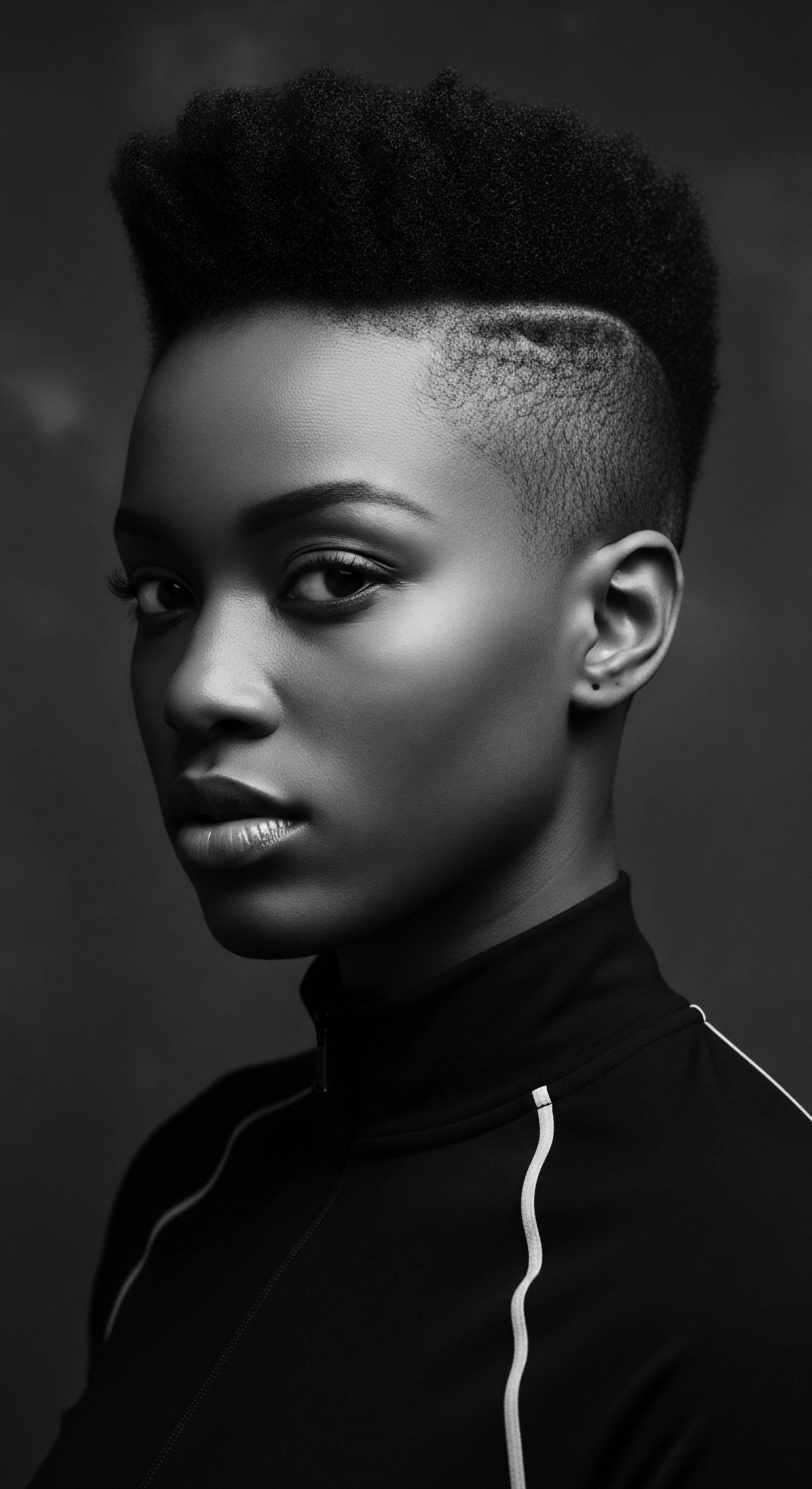
What Specific Evidence Connects Ancient Egyptian Hair Methods to Black and Mixed-Race Experiences?
The use of braids in ancient Egypt provides a clear and compelling link to Black and mixed-race hair heritage. As early as 3500 BCE, rock paintings in the Sahara depict cornrows, signifying the deep ancestral roots of braided styles in Africa. In ancient Egypt, braids were not merely decorative; they conveyed social status, identity, and wealth.
This societal messaging through hair is a cornerstone of African and diasporic hair traditions, where intricate braid patterns often communicated tribal affiliation, marital status, age, or social standing. The very act of braiding, a time-consuming and often communal activity, fostered intergenerational knowledge transfer and community bonds, a tradition that persists in homes and salons across the Black diaspora.
A striking example of this enduring connection can be observed in the widespread use of wigs and extensions. While ancient Egyptians wore wigs for reasons including sun protection, hygiene (to avoid lice on shaved heads), and status, their methods of creating these elaborate pieces involved braiding human hair onto foundations, or even attaching hair extensions directly to existing strands. This practice is directly paralleled in the contemporary Black hair experience, where wigs, weaves, and extensions are not only fashion statements but also invaluable protective styles that shield natural hair from manipulation and environmental damage, allowing it to rest and grow.
Dr. Sally-Ann Ashton, a former curator at the Fitzwilliam Museum, observed this continuity, noting how ancient Egyptian practices with wigs and extensions resonate with what Africans and the African diaspora continue to do today, often facing societal ridicule for such choices despite their deep historical roots.
Consider the mummy of Lady Rai, a nursemaid to Queen Ahmose-Nefertari, dating back to around 1570-1544 BCE. Her well-preserved hair, composed of fine braids, offers a tangible link to ancient styling. This type of archaeological evidence showcases the meticulous care taken, demonstrating a protective intent that extends beyond mere aesthetics into the realm of preservation and longevity. Such deliberate styling choices, designed to maintain hair integrity over extended periods, directly inform the logic behind modern protective styles for textured hair, which prioritize minimal handling and environmental shielding.
The very notion of ‘protective styling’ as a distinct category of hair care finds its ancient precursors in these Egyptian practices. Whether it was the robust structure of a wig shielding the scalp, the interlocked nature of braids preventing tangles and breakage, or the heavy oils providing a lubricating and moisture-retaining layer, the overarching aim was consistently to guard the hair against damage. This heritage of intentional protection, born from environmental necessity and cultural significance, continues to inform the foundational principles of textured hair care in the present day.
The wisdom embedded in these ancient practices speaks directly to the inherent qualities of textured hair—its delicate structure, its propensity for dryness, and its need for deliberate, mindful care. The historical resonance is not merely about aesthetic similarity but about a shared understanding of hair’s biological needs and its profound cultural weight.
- Wig Construction ❉ Ancient Egyptian wigmakers braided human hair onto foundations, often using beeswax and resin to set the styles, creating durable and elaborate protective head coverings.
- Hair Oiling Regimens ❉ The consistent application of natural oils and fats provided a crucial barrier against the dry climate, moisturizing and sealing the hair to prevent breakage.
- Braided Styles ❉ Intricate plaits and twists, both on natural hair and within wigs, minimized manipulation and offered structural protection from daily wear and environmental elements.
The collective wisdom of these ancient practices provides a rich, historical backdrop for understanding the enduring heritage of textured hair care. It offers a powerful counter-narrative to any notion that such protective methods are a modern invention or a response to contemporary challenges alone. They are, in fact, an inheritance, a living archive of ingenuity and reverence for hair.
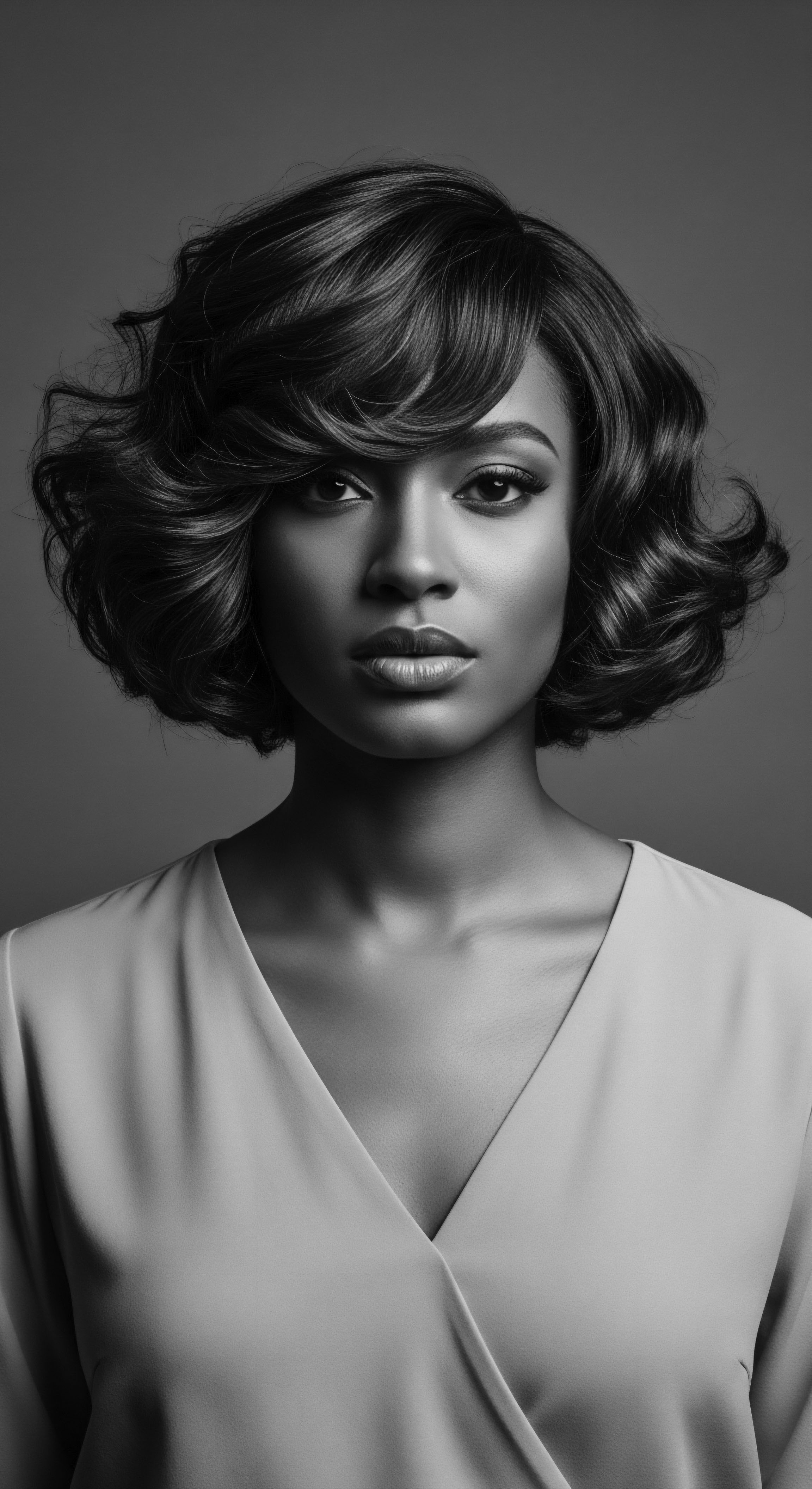
Reflection
As we trace the lineage of textured hair care, from the sandy plains of ancient Kemet to the vibrant expressions of today’s diaspora, a remarkable truth reveals itself. The protective methods employed by ancient Egyptians were not just fleeting trends but a deep-seated understanding of hair’s fragility and its profound place within identity. This is the enduring ‘Soul of a Strand’—a recognition that hair is a living, breathing archive, holding stories, wisdom, and resilience within each curl and coil.
The parallels we uncover between ancient Egyptian wig use and contemporary protective styles, between their rich oiling regimens and our own moisture-sealing practices, are more than coincidental similarities. They are echoes of a shared human endeavor to preserve what is vital, to adorn what is sacred, and to communicate through the very strands that crown our heads. The ingenuity of Kemet, born from environmental necessity and spiritual reverence, flows into the present, nourishing the roots of textured hair heritage.
This continuum speaks to a collective ancestral memory, reminding us that the wisdom we seek often lies in the ancient practices, refined and passed down. Our textured hair, then, becomes a living bridge, connecting us to those who walked the earth before, carrying forward a legacy of care, artistry, and self-possession that time cannot diminish.
References
- McCreesh, N. Gize, A. and David, A. (2011). Image analysis of Egyptian mummy hair. Journal of Archaeological Science, 38(10), pp.2805-2809.
- Grapow, H. von Deines, A. and Westphal, H. (1980). Grundriss der Medizin der Alten Ägypter V. Berlin ❉ Akademie Verlag.
- Fletcher, J. (1995). Ancient Egyptian Hair ❉ An Exploration of Ancient Egyptian Hairstyles and Hair Care Products. University of Manchester Press.
- Robins, G. (2020). Hair, Gender, and Social Status in Ancient Egypt. JSTOR Daily .
- Tassie, G.J. (in press a). The Ancient Egyptian Hairstylist and Barber. In E. Frood, & J. Taylor (Eds.), The Oxford Handbook of Egyptian Epigraphy and Palaeography. Oxford ❉ Oxford University Press.
- Kamal, H. (1991). The Ancient Egyptian Medicine. 1st Edition. Madbouli Library.
- Wilfong, T.G. (1997). Gender and Social Relations in Ancient Egypt. Journal of the American Research Center in Egypt, 34, pp.67-82.
- Petrie, W.M.F. and Mace, A.C. (1901). Diospolis Parva ❉ The Cemeteries of Abadiyeh and Hu, 1898-1899. London ❉ Egypt Exploration Fund.
- Riefstahl, E. (1952). Ancient Egyptian Costumes. Brooklyn ❉ Brooklyn Museum.
- Riefstahl, E. (1956). Thebes in the Time of Amenhotep III. Norman ❉ University of Oklahoma Press.
- Gauthier-Laurent, M.J. (1938). Les Temples funéraires de Deir el-Bahari. Cairo ❉ Institut français d’archéologie orientale.
- Walker, S. and Bierbrier, M. (1997). Ancient Faces ❉ Mummy Portraits from Roman Egypt. London ❉ British Museum Press.
- Plutarch (1936). Isis and Osiris. Translated by F.C. Babbitt. Cambridge, MA ❉ Harvard University Press.
